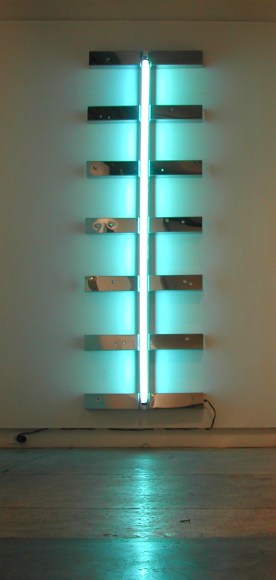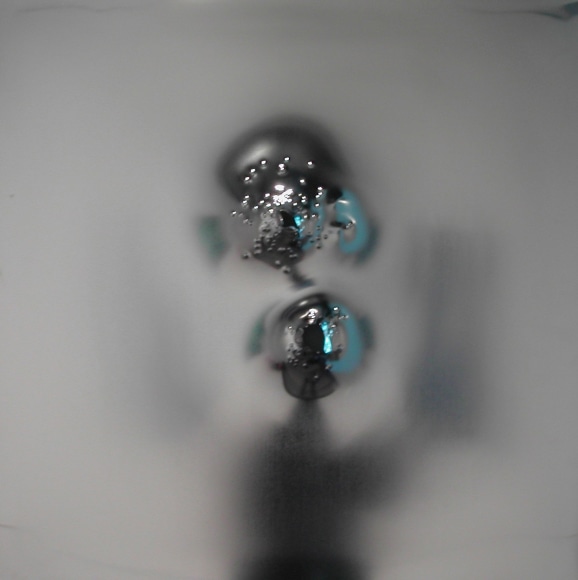My performance and the objects in "Ricochet: The Prodigal Daughter" address the mind/body split claimed by minimalist languages of the 60's. East Coast minimalism declared its weight and physicality circumvented rational thought, as in Carl Andre's feet-on-the-ground, no- illusion material installations. There was the alternative minimalist language of Robert Irwin and James Turrell, which used light and intervention to make us see the spatial environments through our bodily sensations. We can't step on it, or weigh it, still it’s pragmatic, not ironic, rational or intuitive. In this way both minimalisms are intentionally opposed to European rationalism, irony and even intuition. East Coast ideas were more apt to cling to the facts and concreteness of American William James' pragmatism. West Coast minimalism, also fiercely American, related to Emerson's search for the sublime.
My own language is influenced by a New Orleans kind of pragmatism, born of chance and necessity. If it has something fresh to say today it’s because it’s necessary bricolage embraces many cultures and includes the possibility of metaphor.
These are works that were realized through a kind of homesick restlessness after Hurricane Katrina. In the work Lightning 1, there is a rigorous polished steel spine that is embedded with an ethereal column of light. That to me is New Orleans.
Prodigal Daughter, the live performance, speaks to the mind/body split through the use of a Start Pistol. A gut wrenching loud report signals and punctuates the percussive actions of a tap dancer on the gallery's concrete floor. It acts as a catalyst to empower immediate feelings informing the instinctual body, short-circuiting the tyranny of rational thought. The Starting Pistol is used to trigger animal instinct at “the races”. Here it is used as an engine to start the creative process. Sound and rhythm and conditioned response becomes an instrument in transforming the body's acute awareness of the present moment and its relationship to space.
John Cage's music of the minimalist period celebrates silences in the same way this performance celebrates sound. Eventually what could be heard in Cage's silences addressed the mind/body split. Taking what was heard as a negative (shuffling programs, ambient noises) and transforming the "negative" through perceptual acceptance, he strongly influenced many visual artists of the period. Such artists were drawn to using the void as an openness that encourages contemplation, breaks the cycle of compulsive thought and supports human connectedness.
I am attracted to the void as many 60's artists were. It seems there are discoveries within it that may apply now to our new and urgent sense of the world. The surfaces I puncture either by walking on them or shooting through them with bullets are transformed (not destroyed) into contemplative objects allowed by the void. Polished stainless steel objects with voids embody East and West Coast minimalisms. The material has undergone a substance change that refers both to banal reality (bullet holes, stiletto heel prints) and illusion (reflections changed by the surface changes). The light in them refers to the local light of New Orleans. The glow of New Orleans is humid and soft, reflected off delta water that is muddier and less bright than the Hudson River’s steely glare.
Hurricane Katrina led me to sensations of wanting to get down on the floor and look at my process that at the time was one of pacing. I made a video of myself pacing in Kevlar stilettos, putting a digital camera on a stack of books next to the foil faced insulation to be imprinted in this process. The natural light of my Manhattan studio glanced off the foil like light over water. Stills from the video are called "Wade in the Water" for the classic African American Spiritual of the same name, which was encoded with messages for slaves finding their way to the Underground Railroad.
Much art since the Eighties participates in the debate and crises of consumerism with its background story of ironic/rational manipulation of desire. As in the all mythologies of control there is an attempt at closure even in the debate. Behind my video, I like to think, there is an excavated cave, as in Virginia Woolf's Mrs. Dalloway.
In her journal, against the backdrop of another wartime Woolf writes:
I dig out beautiful caves behind my characters. I think that gives them exactly what I want; humanity, humor, depth. The idea is that the caves shall connect, and each comes to daylight in the present moment.











